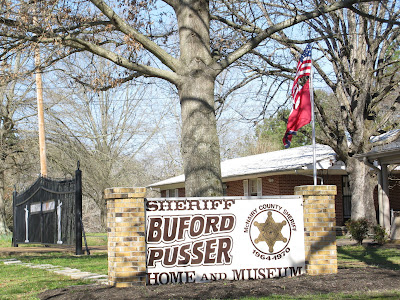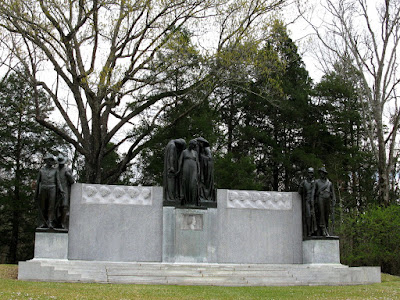Its another nice day and time to get exploring again. As we head to our next history fix, we came across the town of Adamsville, the home of Buford Pusser. If you haven't seen the movie "Walking Tall", you wouldn't have any idea who he is. He was a real sheriff who tried to clean up his town of moonshiners and other ne'er do wells. His true story is more heroic and tragic than Hollywood could have dreamed up. He was shot, stabbed and beat up many times. His wife was murdered and he died in a car crash. Quite a life.
The reason we're down this way is to see the Historic Battlefield site of Shilo. It was one of the major battles of the civil war and started the southern retreat that enabled Grant to push on and burn Atlanta. But, I'm sure you knew all that already. Skip this blog if 150 year old battles don't interest you; but they do us, so here goes. This is the Shilo church after which the battle was named. The original church was in the centre of the battle and was destroyed; this one was eventually built to replace it. Its still an active church inside the park. The first attempt to rebuild used local stone, but they ran out of money. They finally finished it using brick. Can you see the difference?
This is where the welcome centre and interpretive buildings are. Its also the farthest point north that the Northern army retreated on the first day.
In early April, 1862 the Confederate general learned that the union army had marched down to southwest Tennessee and was preparing to attack them in Mississippi. He marched his army of 15000 troops to meet the threat. They arrived about 1 mile from the union army the evening of April 5th. Early on April 6th, they caught the union army by surprise and pushed them back and overran the union camp. The battle stalled as the Rebs ransacked the camp for food and loot. This is a picture of the peach field which was in full bloom during the battle. The field changed hands during the day and they said after the battle that bullets and cannon fire knocked so many petals from the trees that the fallen were covered with so many petals it looked like snow. All the trees were destroyed and the park has now planted a new orchard. Those fence like boxes are protecting the young peach trees from deer.
Along this line, the centre of the union army dug in and although the Rebs threw everything they had at them they held the line. This allowed the other retreating union soldiers to regroup and prevented a general rout. This area became know as the "hornets nest" caused by the sound of so many bullets passing by.
By mid afternoon, the Confederate artillery had massed 62 cannon along a line directly facing the hornets nest and fired directly into the union positions. This was the largest use of cannon during the war. They were forced to retreat and 2500 of them were captured by the Rebs.
This is a statue indicating where the trapped union soldiers surrendered. Almost half of the soldiers who surrendered died as prisoners of war.
This is the union position at the end of the first day. Their cannon and darkness stopped the southern attack. It rained an icy rain most of the night and neither side had any shelter. Wasn't war fun.
The biggest goal of the southern attack was to get between the union army and the Tennessee river but they failed. Overnight, union replacements were ferried across the river as gun boats shelled the Confederate forces all night. A southern defeat was now certain and the next day the union army pushed the Rebs back past the starting point of the battle. The southern army then retreated back to Mississippi.
The weather was warm so General Grant had all bodies buried in a number of mass graves. Over 25000 soldiers died in those 2 days. Almost half of the original Union army and over a third of the Confederates died. 20 years later Union bodies were dug up and buried in this graveyard. Only about 25% of the bodies were identified so most of the headstones don't have a name on them. The river behind me is where the union reinforcements crossed on the night of April 6th.
On a lighter note, we had a great lunch. One of the park wardens told us about a great catfish restaurant about a mile from the park called Catfish Hotel. Apparently, the original owner used to catch and cook up batches of catfish and his visitors would eat and drink until it was too dark to go home so they stayed in this cabin with the owner. It became know as the Catfish Hotel. He was finally talked into starting a restaurant on the site. Thats where we ate although I must admit the current building is much bigger (almost as rustic, but bigger). His cabin was used by the union officers during part of the battle. Quite the history. His great grandkids are still running the restaurant and it claims to be the oldest family owned eatery in the US. The food was delicious. The quantities were so large we brought back enough to have another meal. So we enjoyed it twice. History and fine dining, how can you beat that!











No comments:
Post a Comment